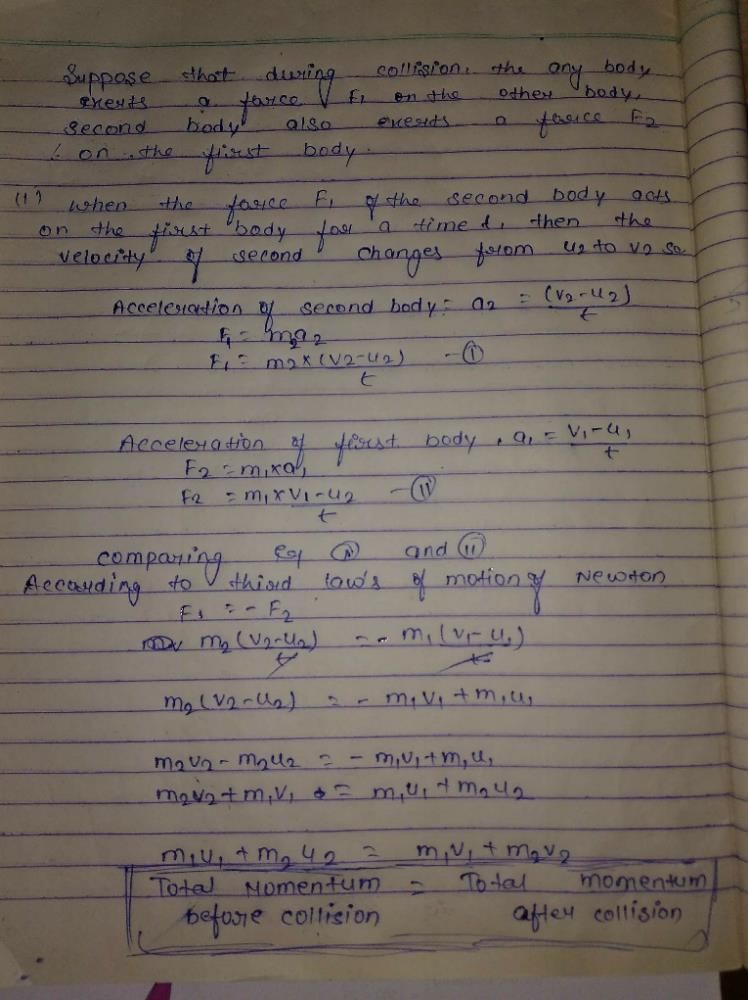Class 9 Exam > Class 9 Questions > Derive law of conservation of momentum using ...
Start Learning for Free
Derive law of conservation of momentum using newton's 3rd law of motion?
Most Upvoted Answer
Derive law of conservation of momentum using newton's 3rd law of motio...
Law of Conservation of Momentum
The law of conservation of momentum states that the total momentum of a closed system of objects (which has no external forces acting on it) remains constant.
Newton's Third Law of Motion
Newton's third law of motion states that for every action, there is an equal and opposite reaction.
Deriving the Law of Conservation of Momentum from Newton's Third Law of Motion
When two objects interact, they exert forces on each other. According to Newton's third law of motion, these forces are equal in magnitude and opposite in direction. Let's consider two objects A and B.
- Object A exerts a force on object B (action).
- Object B exerts an equal and opposite force on object A (reaction).
Now, let's assume that the mass of object A is m1 and its velocity is v1, while the mass of object B is m2 and its velocity is v2.
From Newton's second law of motion, we know that force is equal to the rate of change of momentum. Therefore, the force exerted by object A on object B is given by:
- Force = (m1 * delta v1) / delta t
Similarly, the force exerted by object B on object A is given by:
- Force = (m2 * delta v2) / delta t
Since the forces are equal and opposite, we can equate them:
- (m1 * delta v1) / delta t = -(m2 * delta v2) / delta t
Multiplying both sides by delta t, we get:
- m1 * delta v1 = -m2 * delta v2
Rearranging the equation, we get:
- m1 * delta v1 + m2 * delta v2 = 0
This equation tells us that the total momentum of the system (m1 * v1 + m2 * v2) is conserved. In other words, the total momentum before the interaction is equal to the total momentum after the interaction.
Therefore, we can derive the law of conservation of momentum from Newton's third law of motion.
Community Answer
Derive law of conservation of momentum using newton's 3rd law of motio...

Attention Class 9 Students!
To make sure you are not studying endlessly, EduRev has designed Class 9 study material, with Structured Courses, Videos, & Test Series. Plus get personalized analysis, doubt solving and improvement plans to achieve a great score in Class 9.

|
Explore Courses for Class 9 exam
|

|
Derive law of conservation of momentum using newton's 3rd law of motion?
Question Description
Derive law of conservation of momentum using newton's 3rd law of motion? for Class 9 2024 is part of Class 9 preparation. The Question and answers have been prepared according to the Class 9 exam syllabus. Information about Derive law of conservation of momentum using newton's 3rd law of motion? covers all topics & solutions for Class 9 2024 Exam. Find important definitions, questions, meanings, examples, exercises and tests below for Derive law of conservation of momentum using newton's 3rd law of motion?.
Derive law of conservation of momentum using newton's 3rd law of motion? for Class 9 2024 is part of Class 9 preparation. The Question and answers have been prepared according to the Class 9 exam syllabus. Information about Derive law of conservation of momentum using newton's 3rd law of motion? covers all topics & solutions for Class 9 2024 Exam. Find important definitions, questions, meanings, examples, exercises and tests below for Derive law of conservation of momentum using newton's 3rd law of motion?.
Solutions for Derive law of conservation of momentum using newton's 3rd law of motion? in English & in Hindi are available as part of our courses for Class 9.
Download more important topics, notes, lectures and mock test series for Class 9 Exam by signing up for free.
Here you can find the meaning of Derive law of conservation of momentum using newton's 3rd law of motion? defined & explained in the simplest way possible. Besides giving the explanation of
Derive law of conservation of momentum using newton's 3rd law of motion?, a detailed solution for Derive law of conservation of momentum using newton's 3rd law of motion? has been provided alongside types of Derive law of conservation of momentum using newton's 3rd law of motion? theory, EduRev gives you an
ample number of questions to practice Derive law of conservation of momentum using newton's 3rd law of motion? tests, examples and also practice Class 9 tests.

|
Explore Courses for Class 9 exam
|

|
Suggested Free Tests
Signup for Free!
Signup to see your scores go up within 7 days! Learn & Practice with 1000+ FREE Notes, Videos & Tests.























